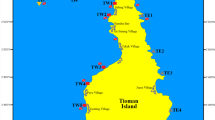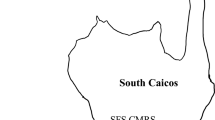Abstract
In this study, we assess coral health by detecting the severity of coral diseases and compromised health states on massive Porites. Field surveys are conducted at twenty-two sites covering the eastern, inner and western Gulf of Thailand as well as the Andaman Sea during 2010–2015. A total of nine coral diseases and signs of compromised health are observed in the waters of Thailand, consisting of pigmentation responses (pink lines, pink patches, pink spots and pink borers), white syndromes (white patches, white bands and ulcerative white spots), growth anomalies, and unusual bleaching patterns. The highest severity of all observed coral diseases and signs of compromised health are found at Ko Khang Khao in the inner Gulf of Thailand, while that observed in the Andaman Sea is relatively low. Composition of the diseases vary across the study sites. Four groups of study sites, in which there is an 80% similarity of diseases or signs of compromised health composition, are clustered and detected based on the Bray-Curtis similarity. The canonical analysis of principal coordinates reveal that most study sites in the Gulf of Thailand, especially the inner Gulf of Thailand, tend to show a high severity of the diseases. The association of disease severity and composition and the level of human impact are also detected. The study sites located near the shores and/or the areas with intensive tourism tend to have higher human impact, especially on poor water quality, which may be linked to the higher severity and composition of coral diseases and signs of compromised health in the Gulf of Thailand. Fish bites are also observed in many study sites. The severity of fish bites in the Gulf of Thailand is much lower compared to the Andaman Sea. Ko Rawi exhibits the highest severity, following by Ko Surin Nua and Ko Butang. The study sites within marine national park boundaries have a significantly higher severity of fish bites than those outside of the marine national park boundaries. This study suggests that higher coral diseases and signs of compromised health severity might be linked to anthropogenic disturbances on coral communities in the waters of Thailand.
Similar content being viewed by others
References
Aeby G S, Williams G J, Franklin E C, et al. 2011. Growth anomalies on the coral genera Acropora and Porites are strongly associated with host density and human population size across the Indo–Pacific. PLoS One, 6(2): e16887, doi: 10.1371/journal.pone. 0016887
Anderson M J, Gorley R N, Clarke K R. 2008. PERMANOVA+ for PRIMER: Guide to Software and Statistical Methods. Plymouth, UK: Primer–E, 214
Angkhananukroh P, Kritsanapuntu S, Chaitanawisuti N, et al. 2016. Preliminary survey on disease prevalence in dominant massive coral Porites lutea in three reef communities at Sichang Island group, the Eastern Gulf of Thailand. Journal of Biodiversity and Environmental Sciences, 8(5): 108–115
Aronson R B, Precht W F. 2001. White–band disease and the changing face of Caribbean coral reefs. Hydrobiologia, 460(1–3): 25–38
Baker D M, MacAvoy S E, Kim K. 2007. Relationship between water quality, δ15N, and aspergillosis of Caribbean sea fan corals. Marine Ecology Progress Series, 343: 123–130, doi: 10.3354/meps06937
Beeden R, Willis B L, Raymundo L J, et al. 2008. Underwater cards for assessing coral health on indo–pacific reefs. In: Melbourne: Coral Reef Targeted Research and Capacity Building for Management Program. St. Lucia: Currie Communications, 26
Bonaldo R M, Pires M M, Guimarães P R Junior, et al. 2017. Small marine protected areas in Fiji provide refuge for reef fish assemblages, feeding groups, and corals. PLoS One, 12(1): e0170638, doi: 10.1371/journal.pone.0170638
Bray J R, Curtis J T. 1957. An ordination of the upland forest communities of Southern Wisconsin. Ecological Monographs, 27(4): 325–349, doi: 10.2307/1942268
Bruno J F, Petes L E, Harvell C D, et al. 2003. Nutrient enrichment can increase the severity of coral diseases. Ecology Letters, 6(12): 1056–1061, doi: 10.1046/j.1461–0248.2003.00544.x
Clarke K R, Gorley R N. 2015. PRIMER v7: User Manual/Tutorial. Plymouth: PRIMER–E, 1–296
Couch C S, Garriques J D, Barnett C, et al. 2014. Spatial and temporal patterns of coral health and disease along leeward Hawai’i Island. Coral Reefs, 33(3): 693–704, doi: 10.1007/s00338–014–1174–x
Donsomjit W, Yeemin T. 2010. Patterns of pink syndrome in Porites lutea at Koh Lan, Gulf of Thailand. In: Supasiri T, Wilaiwan T, Raksakiat S. eds. Proceedings of the 36th Congress on Science and Technology of Thailand. Bangkok, Thailand: The Science Society of Thailand under the Patronage of His Majesty the King, 1–5
Erftemeijer P L A, Riegl B, Hoeksema B W, et al. 2012. Environmental impacts of dredging and other sediment disturbances on corals: a review. Marine Pollution Bulletin, 64(9): 1737–1765, doi: 10.1016/j.marpolbul.2012.05.008
Harvell C D, Jordán–Dahlgren E, Merkel S, et al. 2007. Coral disease, environmental drivers, and the balance between coral and microbial associates. Oceanography, 20(1): 172–195, doi: 10.5670/oceanog
Heron S F, Willis B L, Skirving W J, et al. 2010. Summer hot snaps and winter conditions: modelling white syndrome outbreaks on Great Barrier Reef corals. PLoS One, 5(8): e12210, doi: 10.1371/journal.pone.0012210
Jompa J, McCook L J. 2003. Coral–algal competition: macroalgae with different properties have different effects on corals. Marine Ecology Progress Series, 258: 87–95, doi: 10.3354/meps258087
Kaczmarsky L, Richardson L L. 2011. Do elevated nutrients and organic carbon on Philippine reefs increase the prevalence of coral disease? Coral Reefs, 30(1): 253–257, doi: 10.1007/s00338–010–0686–2
Kenkel D C. 2008. Coral disease: baseline surveys in the Andaman Sea and Gulf of Thailand. Phuket Marine Biological Center Research Bulletin, 69: 43–53
Kritsanapuntu S, Angkhananukroh P. 2014. Coral disease prevalence in Samui Island and the adjacent islands, southern part of the Gulf of Thailand. Journal of Biodiversity and Environmental Sciences, 5(4): 158–165
Lamb J B, True J D, Piromvaragorn S, et al. 2014. Scuba diving damage and intensity of tourist activities increases coral disease prevalence. Biological Conservation, 178: 88–96, doi: 10.1016/j.biocon.2014.06.027
Myers R L, Raymundo L J. 2009. Coral disease in Micronesian reefs: a link between disease prevalence and host abundance. Diseases of Aquatic Organisms, 87(1–2): 97–104
Palmer C V, Mydlarz L D, Willis B L. 2008. Evidence of an inflammatory–like response in non–normally pigmented tissues of two scleractinian corals. Proceedings of the Royal Society B: Biological Sciences, 275(1652): 2687–2693, doi: 10.1098/rspb. 2008.0335
Patankar V, D'Souza E, Alcoverro T, et al. 2016. For traditional island communities in the Nicobar archipelago, complete no–go areas are the most effective form of marine management. Ocean & Coast Manage, 133: 53–63
Pollock F J, Lamb J B, Field S N, et al. 2016. Sediment and turbidity associated with offshore dredging increase coral disease prevalence on nearby reefs. PLoS One, 9(7): e0102498
Putchim L, Yamarunpattana C, Phongsuwan N. 2012. Observations of coral disease in Porites lutea in the Andaman Sea following the 2010 bleaching. Phuket Marine Biological Center Research Bulletin, 71: 57–62
Ravindran J, Raghukumar C. 2006. Pink–line syndrome, a physiological crisis in the scleractinian coral Porites lutea. Marine Biology, 149(2): 347–356, doi: 10.1007/s00227–005–0192–1
Raymundo L J, Couch C S, Harvell C D. 2008. Coral Disease Handbook: Guidelines for Assessment, Monitoring & Management. Melbourne: Currie Communications Ltd, 1–121
Roder C, Arif C, Bayer T, et al. 2014. Bacterial profiling of White Plague Disease in a comparative coral species framework. The ISME Journal, 8(1): 31–39, doi: 10.1038/ismej.2013.127
Samsuvan W, Yeemin T, Ruangthong C, et al. 2017a. Prevalence of white syndromes on the dominant coral Porites spp. at tourist hotspots in Khao Laem Ya–Mu Ko Samet National Park. In: Potiyaraj P, Pinyakong O. eds. Proceedings of the 43th Congress on Science and Technology of Thailand. Bangkok, Thailand: The Science Society of Thailand under the Patronage of His Majesty the King, 309–313
Samsuvan W, Yucharoen M, Yeemin T, et al. 2017b. Cellular investigation of a coral disease, white syndrome using histopathological study. In: Sarakonsri T, et al. eds. Proceedings of the 34th MST Annual Conference. Bangkok, Thailand: The Microscopy Society of Thailand, 183–186
Sangmanee K, Sutthacheep M, Yeemin T. 2012. The decline of the sea urchin Diadema setosum affected by multiple disturbances in the inner Gulf of Thailand. In: Proceedings of 12th International Coral Reef Symposium. Cairns, Australia: MBRG, 4
Sato Y, Bourne D G, Willis B L. 2009. Dynamics of seasonal outbreaks of black band disease in an assemblage of Montipora species at Pelorus Island (Great Barrier Reef, Australia). Proceedings of the Royal Society B: Biological Sciences, 276(1668): 2795–2803, doi: 10.1098/rspb.2009.0481
Sato Y, Civiello M, Bell S C, et al. 2016. Integrated approach to understanding the onset and pathogenesis of black band disease in corals. Environmental Microbiology, 18(3): 752–765, doi: 10.1111/1462–2920.13122
Sheridan C, Grosjean P, Leblud J, et al. 2014. Sedimentation rapidly induces an immune response and depletes energy stores in a hard coral. Coral Reefs, 33(4): 1067–1076, doi: 10.1007/s00338–014–1202–x
Shi Qi, Liu Guohui, Yan Hongqiang, et al. 2012. Black disease (Terpios hoshinota): a probable cause for the rapid coral mortality at the northern reef of Yongxing Island in the South China Sea. Ambio, 41(5): 446–455, doi: 10.1007/s13280–011–0245–2
Shidqi R A, Pamuji B, Sulistiantoro T, et al. 2018. Coral health monitoring at Melinjo Island and Saktu Island: influence from Jakarta Bay. Regional Studies in Marine Science, 18: 237–242, doi: 10.1016/j.rsma.2017.02.004
Suraswadi P, Yeemin T. 2013. Coral reef restoration plan of Thailand. Galaxea, Journal of Coral Reef Studies, 15(S1): 428–433
Sutherland K P, Porter J W, Torres C. 2004. Disease and immunity in Caribbean and Indo–Pacific zooxanthellate corals. Marine Ecology Progress Series, 266: 273–302, doi: 10.3354/meps266273
Sutthacheep M, Yeemin T, Saenghaisuk C, et al. 2009. Assessing coral health in the Gulf of Thailand. In: Noparatnanaporn N, et al. eds. Proceedings of the 35th Congress on Science and Technology of Thailand. Bangkok, Thailand: The Science Society of Thailand under the Patronage of His Majesty the King, 1–5
Takabayashi M, Gregg T M, Farah E, et al. 2008. The prevalence of skeletal growth anomaly and other afflictions in scleractinian corals in Wai’ōpae, Hawai’i. In: Riegl B, Dodge R E. eds. Proceedings of the 11th International Coral Reef Symposium. Ft. Lauderdale, Florida: Nova Southeastern University National Coral Reef Institute, 820–824
Ushijima B, Videau P, Burger A H, et al. 2014. Vibrio coralliilyticus strain OCN008 is an etiological agent of acute Montipora white syndrome. Applied and Environmental Microbiology, 80(7): 2102–2109, doi: 10.1128/AEM.03463–13
Voss J D, Richardson L L. 2006. Nutrient enrichment enhances black band disease progression in corals. Coral Reefs, 25(4): 569–576, doi: 10.1007/s00338–006–0131–8
Weil E. 2004. Coral reef diseases in the wider Caribbean. In: Rosenberg E, Loya Y, eds. Coral Health and Disease. Berlin: Springer–Verlag, 35–68
Weil E, Irikawa A, Casareto B, et al. 2012. Extended geographic distribution of several Indo–Pacific coral reef diseases. Diseases of Aquatic Organisms, 98(2): 163–170, doi: 10.3354/dao02433
Work T, Meteyer C. 2014. To understand coral disease, look at coral cells. EcoHealth, 11(4): 610–618, doi: 10.1007/s10393–014–0931–1
Work T M, Aeby G S. 2006. Systematically describing gross lesions in corals. Diseases of Aquatic Organisms, 70(1–2): 155–160
Yeemin T, Mantachitra V, Plathong S, et al. 2012. Impacts of coral bleaching, recovery and management in Thailand. In: Yellowlees, D, Hughes, T P. eds. Proceedings of the 12th International Coral Reef Symposium. Cairns, Australia: James Cook University, 1–5
Yeemin T, Saenghaisuk C, Sutthacheep M, et al. 2009. Conditions of coral communities in the Gulf of Thailand: a decade after the 1998 severe bleaching event. Galaxea, Journal of Coral Reef Studies, 11(2): 207–217, doi: 10.3755/galaxea.11.207
Acknowledgements
We thank the staff of Department of National Parks, Wildlife and Plant Conservation and Marine Biodiversity Research Group, Faculty of Science, Ramkhamhaeng University for their supports.
Author information
Authors and Affiliations
Corresponding author
Additional information
Foundation item: The budget for research promotion from the Government of Thailand to Ramkhamhaeng University.
Rights and permissions
About this article
Cite this article
Samsuvan, W., Yeemin, T., Sutthacheep, M. et al. Diseases and compromised health states of massive Porites spp. in the Gulf of Thailand and the Andaman Sea. Acta Oceanol. Sin. 38, 118–127 (2019). https://doi.org/10.1007/s13131-019-1378-6
Received:
Accepted:
Published:
Issue Date:
DOI: https://doi.org/10.1007/s13131-019-1378-6




